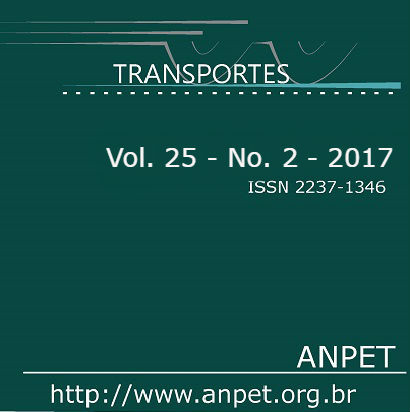Method for measuring factors that affect the performance of pilots
DOI:
https://doi.org/10.14295/transportes.v25i2.1374Keywords:
Air Transport. Accidents. Safety. Factors Human. Bayesian Belief Networks.Abstract
This paper presents the development of a model of accident analysis according to the principal factors which influence aeronautical accidents that are able to assess any aircraft accident, taking into account human, organizational, environmental and airport infrastructure factors. The methodology of data collection of this research was through the literature, analysis of aircraft accident reports, technical visits to the center of certification of commercial aircraft pilots and interviews with industry experts. From this model, it is possible to evaluate the influence of these factors and identify the dependence and relationship existing, and how they influence the system. With the aid of Bayesian Networks technique, it is also possible to quantify the factors and assess which ones have more impact in the system. The results show the relationship between the factors that can influence the performance of the pilots and therefore can indicate how it may impact the success or failure of tasks related to flight procedures. The results also may indicate subsidies for mitigating actions, collaborating in the management of operational safety of air transport and assessing the overall impact of the factors that determine any accident.
Downloads
References
Aircraft Owners and Pilots Association (2008). Aeronautical decision making: pilot's handbook of aeronautical knowledge. AOPA, Chapter 16, pp. 16-1 – 16-9. Available: <http://download.aopa.org/epilot/2008/8083-25-chap16.pdf> [21 May 2015].
Ale, B.J.M., Bellamy, L.J., van der Boom, R., Cooper, J., Cooke, R.M., Goossens, L.H.J., Hale, A.R., Kurowicka, D., Morales, O., Roelen, A.L.C.,
Spouge, J. (2009). Further development of a Causal model for Air Transport Safety (CATS): Building the mathemat-ical heart. Reliab. Eng. Syst. Saf. n. 94, p. 1433–1441. DOI:10.1016/j.ress.2009.02.024.
Ashford, N.; Wright, P. H. (1992). Airport engineering. 3 ed. U. S.: A Wiley-Interscience Publication.
Aven, T., Zio, E. (2011). Some considerations on the treatment of uncertainties in risk assessment for practical decision mak-ing. Reliability Engineering & System Safety, n. 96, p. 64–74. DOI:10.1016/j.ress.2010.06.001.
Ayres, M., Shirazi, H., Carvalho, R., Hall J., Speir, R., Arambula, E., David, R., Wong, D., Gadzinski, J. (2011). ACRP Report 50: Im-proved Model for Risk Assessment of Runway Safety Areas. Airport Cooperative Research Program. Transportation Re-search Board, Washington, DC. DOI: 10.17226/13635.
Boeing (2010). Report of the boing company. pp.156. Available: http://www.boeing.com/assets/pdf/companyoffices/ finan-cial/finreports/ annual/2011/ annual_report.pdf. [11 April 2016].
Cabral, L.; Pirovani, M.; Fernandes, R.; Torres, L.; Perdigão, D.; Medeiros Junior, A.; Costa, J.; Modelli Junior, E. (2014). Análise de runway excursion: aspectos humanos, operacionais e estruturais na aviação de transporte aéreo regular, 80f. Tra-balho de Conclusão de Curso (Lato Senso) – Instituto Tecnológico de Aeronáutica, São José dos Campos.
Caltrans (2002). California airport land use planning handbook. California Department of Transportation, Division of Aero-nautics. pp.455. Available: <http://www.dot.ca.gov/hq/planning/aeronaut/documents/alucp/AirportLandUsePlanningHandbook.pdf> [06 May 2016].
Chang, Y.H.J., Mosleh, A. (2007). Cognitive modeling and dynamic probabilistic simulation of operating crew response to complex system accidents. Part 2: IDAC performance influencing factors model. Reliability Engineering and System Safety, n. 92, p. 1014–1040. DOI:10.1016/j.ress.2006.05.010.
Centro de Investigação e Prevenção de Acidentes Aeronáuticos (2013). Saída de pista na aviação civil brasileira: estatísticas 2004 a 2013. Report, 25 p. Cenipa. Força Aérea Brasileira.
Cowell, R.G., Dawid, A.P., Lauritzen, S.L., Spiegelhalter, D.J. (1999). Probabilistic networks and expert systems. New York: Spring-er-Verlag,. DOI:10.1007/b97670.
Dismukes, K., Young, G.; Sumwalt, R. (1999). Cockpit interruptions and distractions: effective management requires a careful balancing act. Airline Pilot, v. 68, n. 5.
Flight Safety Foundation (2009). Reducing the risk of runway excursions: report of the runway safety initiative. Alexandria, US.
Greenberg, R. (2007). A quantitative safety model of systems subject to low probability high consequence accidents. School of Electrical and Information Engineering, University of South Australia.
Greenberg, R., Cook, S.C., Harris, D. (2005). A civil aviation safety assessment model using a bayesian belief network (BBN). Aer-onaut. J. 109, I–XII. DOI:10.1017/S0001924000000981.
Hall, J., Ayres Jr., M., Wong, D., Appleyard, A., Eddowes, M., Shirazi, H., Speir, R., Pitfield, D., Caves, R., Selezneva, O., Puzin, T. (2008). ACRP Report 3: analysis of aircraft overruns and undershoots for runway safety areas. Transportation Research Board, Washington, D.C. DOI:10.17226/14137.
Heinrich, H.W., Petersen, D., Roos, N. (1980). Industrial accident prevention: safety management approach, 5th ed. McGraw – Hill, New York.
Hollnagel, E. (2004). Barriers and accident prevention. Hampshire: Ashgate.
International Air Transport Association (2014). Annual Review 2014. IATA, Montreal.
Jensen, F. V, Nielsen, T.D. (2007). Bayesian networks and decision graphs, information science and statistics. New York: Springer. DOI:10.1007/978-0-387-68282-2.
Jensen, F.V. (1996). An introduction to bayesian networks. London: Taylor and Francis,
Kolaczkowski, A., Forester, J., Lois, E., Cooper, S. (2005). Good practices for implementing human reliability analysis, NUREG-1792. Washington, D.C. : Nuclear Regulatory Commission,
Langseth, H., Portinale, L. (2007). Bayesian networks in reliability. Reliab. Eng. Syst. Saf. v. 92, p. 92–108. DOI:10.1016/j.ress.2005.11.037.
Leveson, N. (2003). A new approach to system safety engineering, Cambridge, MA: Aeronautics and Astronautics Depart-ment, Massachusetts Institute of Technology. Available: <http://sunnyday.mit.edu >.
Leveson, N. (2004). A new accident model for engineering safer systems. Safety Science, n. 42, p. 237–270. DOI:10.1016/S0925-7535(03)00047-X.
Luxhøj, J.T., Coit, D.W. (2006). Modeling low probability/high consequence events: an aviation safety risk model, In: ANNUAL RELIABILITY AND MAINTAINABILITY SYMPOSIUM. Proceedings… p. 215–221. DOI:10.1109/RAMS.2006.1677377.
Martins, M.R., Maturana, M.C. (2010). Human error contribution in collision and grounding of oil tankers. Risk Anal. n. 30, p. 674–698. DOI:10.1111/j.1539-6924.2010.01392.x.
Martins, M.R., Maturana, M.C. (2013). Application of Bayesian Belief networks to the human reliability analysis of an oil tank-er operation focusing on collision accidents. Reliab. Eng. Syst. Saf. v. 110, p. 89–109. DOI:10.1016/j.ress.2012.09.008.
Maurino, D.E., Reason, J., Johnston, N., Lee, R.B. (1995). Beyond aviation human factors: safety in high technology systems, al-dershot, United Kingdom: Avebury Aviation.
Mohaghegh, Z.; Kazemi, R.; Mosleh, A. (2008). A hybrid technique for organizational safety risk analysis. In: CONFERENCE PSAM 9, 2008. Proceedings… Hong Kong, p. 19-23/5-08.
Neapolitan, R.E. (2004). Learning bayesian networks. Prentice Hall.
Pearl, J. (1988). Probabilistic reasoning in intelligent systems: networks of plausible inference, morgan kaufmann series in representation and reasoning. San Mateo, Calif: .Morgan Kaufmann,
President's Airport Commission (1952). The airport and its neighbors. Government Printing Office 116 pp., May 16. Availa-ble: <http://www.dot.state.mn.us/aero/planning/documents/ airportanditsneighbors.pdf> [03 June 2016].
Rasmussen, J. (1997). Risk Management in a Dynamic Society: A Modelling Problem. Safety Science. v. 27, n. 2, p. 183-213. DOI:10.1016/S0925-7535(97)00052-0.
Roelen, A. (2008). Rationale behind performance shaping factors for generic human operator models. NLR Air Transport Safety Institute.
Roelen, A.L.C., Lin, P.H., Hale, A.R. (2011). Accident models and organisational factors in air transport: the need for multi-method models. Saf. Sci. n. 49, p. 5–10. DOI:10.1016/j.ssci.2010.01.022.
Røed, W., Mosleh, A., Vinnem, J.E., Aven, T. (2009). On the use of the hybrid causal logic method in offshore risk analysis. Reli-ability Engineering and System Safety, n. 94, p. 445–455. DOI:10.1016/j.ress.2008.04.003.
Sundaramurthi, R., Smidts, C. (2013). Human reliability modeling for the Next Generation System Code. Ann. Nucl. Energy, n. 52, p. 137–156. DOI:10.1016/j.anucene.2012.07.027.
Swain, A.D., Guttmann, H.E. (1983). Handbook of human-reliability analysis with emphasis on nuclear power plant applica-tions. Final report, U.S. Nuclear Regulatory Commission, NUREG/CR-1278. DOI:10.2172/5752058.
Thaden, T.L., Wiegmann, D.A., Shappell, S.A. (2004). Measuring organizational factors measuring organizational factors in airline safety. Technical Report AHFD-03-11/FAA-03-3. Illinois: Savoy,
Yacavone, D. (1993). Mishap trends and cause factors in naval aviation: a review of naval safety center data, 1986-90. Avia-tion, Space and Environmental Medicine, n. 64, p. 392-395.
Wiegmann, D.A., Shappell, S.A. (2001). A human error analysis of commercial aviation accidents using the human factors analysis and classification system (HFACS). Aviat. Space. Environ. Med. n. 72, p. 1006–101. DOI:10.1037/e420582004-001.
Downloads
Published
How to Cite
Issue
Section
License
Authors who submit papers for publication by TRANSPORTES agree to the following terms:
- Authors retain copyright and grant TRANSPORTES the right of first publication with the work simultaneously licensed under a Creative Commons Attribution License that allows others to share the work with an acknowledgement of the work's authorship and initial publication in this journal.
- Authors may enter into separate, additional contractual arrangements for the non-exclusive distribution of this journal's published version of the work (e.g., post it to an institutional repository or publish it in a book), with an acknowledgement of its initial publication in TRANSPORTES.
- Authors are allowed and encouraged to post their work online (e.g., in institutional repositories or on their website) after publication of the article. Authors are encouraged to use links to TRANSPORTES (e.g., DOIs or direct links) when posting the article online, as TRANSPORTES is freely available to all readers.
- Authors have secured all necessary clearances and written permissions to published the work and grant copyright under the terms of this agreement. Furthermore, the authors assume full responsibility for any copyright infringements related to the article, exonerating ANPET and TRANSPORTES of any responsibility regarding copyright infringement.
- Authors assume full responsibility for the contents of the article submitted for review, including all necessary clearances for divulgation of data and results, exonerating ANPET and TRANSPORTES of any responsibility regarding to this aspect.









